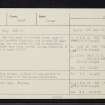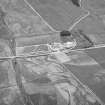Auchinhove
Temporary Camp (Roman)
Site Name Auchinhove
Classification Temporary Camp (Roman)
Canmore ID 17349
Site Number NJ45SE 5
NGR NJ 46185 51705
NGR Description Centred NJ 46185 51705
Datum OSGB36 - NGR
Permalink http://canmore.org.uk/site/17349
- Council Moray
- Parish Grange
- Former Region Grampian
- Former District Moray
- Former County Banffshire
NJ45SE 5 centred 46185 51705
(NJ 4630 5167) The crop mark of a buried ditch, part of the E side with probable clavicula, and rounded NE angle of a Roman camp, was identified in 1949 at Auchinhove. The S and W sides were later traced, giving dimensions of 1,030'E-W by at least 1,100'.
Roman Camp visible on RAF air photographs DF2, 5, 6, 16; GQ 39; AKD 40; AAF 67.
J K St Joseph 1951; J K St Joseph 1961.
No surface traces. Outline of camp plotted at 1:2500 from St Joseph AP'S and ground observation.
Visited by OS (RL) 14 July 1967.
Stracathro type. Flavian.
J K St Joseph 1969.
The position of the S side was established by digging. The N-S dimension of the camp is now not less than 1,150', giving a minimum area of 30 acres.
J K St Joseph 1973.
Publication Account (17 December 2011)
The camp at Auchinhove was first recorded from the air by St Joseph in 1949 (St Joseph 1951a, 65). It lies to the east of Keith, in low-lying ground just to the north of the River Isla close to the Pass of Grange. The camp of Muiryfold lies about 2.5 km to the east. The presence of the camp of Auchinhove has been used to argue for nearby Knock Hill (just over 8 km to the north-east) as the site of the Battle of Mons Graupius, with Auchinhove established after the battle, and after the Pass of Grange had been secured (Burn 1953, 132-3). The camp has been placed in the Flavian period due to the presence of a 'stracathro-type' gate (St Joseph 1958, 93) in its east side.
The camp lies in a series of arable fields to the south of the A95 from Banff to Keith. Parts of three sides are known from air photographs with a corner suggesting the position of the fourth, along the side of the road. There is an external clavicula and oblique traverse ('stracathro-type') entrance on the ESE side. The camp measures some 337m from NNE to SSW by 328m transversely and encloses some 10.9 ha (27 acres). St Joseph conducted excavations on several occasions, recording that the ditch on the SSE side was small, measuring only 0.85m in width by 0.7m in depth (RCAHMS St Joseph Collection: Notebook 2). He also excavated three other trenches on the SSE side with slightly smaller dimensions (RCAHMS St Joseph Collection: Notebook 1), and five further trenches across the SSW side to establish the location of that side several years later (RCAHMS St Joseph Collection: Notebook 6), because there are two sets of linear cropmarks that could represent that side of the camp.
R H Jones 2011




















